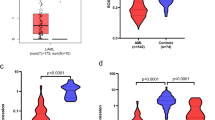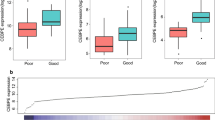Abstract
Acute myeloid leukemia (AML) is a clonal disease, characterized by the growth and accumulation of immature cells in the bone marrow, which in turn affects production of normal blood cells. Increasing need for biomarkers that can predict the outcome of treatment are becoming of potential value because of the heterogenous response to induction chemotherapy. FCHSD2 was identified as a potential chemoprotector. In the present study, we used qRT-PCR to assess FCHSD2 expression levels in peripheral blood or bone marrow blasts of 50 de novo AML patients before remission induction chemotherapy. There was higher expression levels of mRNA in AML patients than control group median (1.36, 0.70), respectively. Patients were subgrouped into responders(R) and nonresponders (NR) after remission induction therapy. The mean expression level of FCHSD2 mRNA in responders (32/50) was 1.7 ± 2.8, while it was 7.9 ± 6.6 in NR (18/50). Our results demonstrated that the patients with lower FCHSD2 expression prior to the treatment had an increased chance of attaining remission compared to patients with high-level FCHSD2. In conclusion, our data suggests that FCHSD2 can serve as a new biomarker for the prediction of treatment outcome in AML patients. The quantitation of FCHSD2 expression at the time of diagnosis could help to identify the responses to chemotherapy.


Similar content being viewed by others
References
Bonnet D, Dick JE (1997) Human acute myeloid leukemia is organized as a hierarchy that originates from a primitive hematopoietic cell. Nat Med 3:730–7
Buccisano F, Maurillo L, Del Principe MI et al (2012) Prognostic and therapeutic implications of minimal residual disease detection in acute myeloid leukemia. Blood 119(2):332–341
Estey EH (2001) Prognostic factors in acute myelogenous leukemia. Leukemia 15:670–2
Gregory TK, Wald D, Chen Y, Vermaat JM, Xiong Y, Tse W (2009) Molecular prognostic markers for adult acute myeloid leukemia with normal cytogenetics. J Hematol Oncol 2:23
Han Y, San-Marina S, Yang L, Khoury H, Minden MD (2007) The zinc finger domain of Wilms’ tumor 1 suppressor gene (WT1) behaves as a dominant negative, leading to abrogation of WT1 oncogenic potential in breast cancer cells. Breast Cancer Res 9:R43
Han Y, Cui J, Lu Y et al (2012) FCHSD2 predicts response to chemotherapy in acute myeloid leukemia patients. Leuk Res 36:1339–1346
Hirsch P, Tang R, Marzac C, Perrot JY, Fava F, Bernard C et al (2011) Prognostic impact of high ABC transporters activity in 111 adult acute myeloid leukemia with normal cytogenetics when compared to FLT3, NPM1. CEBPA and BAALC Haematologica. doi:10.3324/haematol.2010.034447
Katoh M, Katoh M (2004) Identification and characterization of human FCHSD1 and FCHSD2 genes in silico. Int J Mol Med 13:749–54
Kern W, Haferlach T, Schoch C, Loffler H, Gassmann W, Heinecke A et al (2003) Early blast clearance by remission induction therapy is a major independent prognostic factor for both achievement of complete remission and long-term outcome in acute myeloid leukemia: data from the German AML Cooperative Group (AMLCG) 1992 Trial. Blood 101:64–70
Koreth J, Schlenk R, Kopecky KJ et al (2009) Allogeneic stem cell transplantation for acute myeloid leukemia in first complete remission: systematic review and metaanalysis of prospective clinical trials. JAMA 301(22):2349–2361
Ohno H, Hirabayashi S, Kansaku A, Yao I, Tajima M, Nishimura W et al (2003) Carom: a novel membrane-associated guanylate kinase-interacting protein with two SH3 domains. Oncogene 22:8422–31
Tenen DG (2003) Disruption of differentiation in human cancer: AML shows the way. Nat Rev Cancer 3:89–101
Valk PJ, Verhaak RG, Beijen MA et al (2004) Prognostically useful gene expression profiles in acute myeloid leukemia. N Engl J Med 350:1617–28
Valk PJ, Delwel R, Lowenberg B (2005) Gene expression profiling in acute myeloid leukemia. Curr Opin Hematol 12:76–81
Author information
Authors and Affiliations
Corresponding author
Rights and permissions
About this article
Cite this article
El Dahshan, D., Metwaly, H., Sheir, R. et al. High expression of FCHSD2 is associated with chemoresistance in adult acute myeloid leukemia. Comp Clin Pathol 23, 1441–1446 (2014). https://doi.org/10.1007/s00580-013-1802-9
Received:
Accepted:
Published:
Issue Date:
DOI: https://doi.org/10.1007/s00580-013-1802-9




